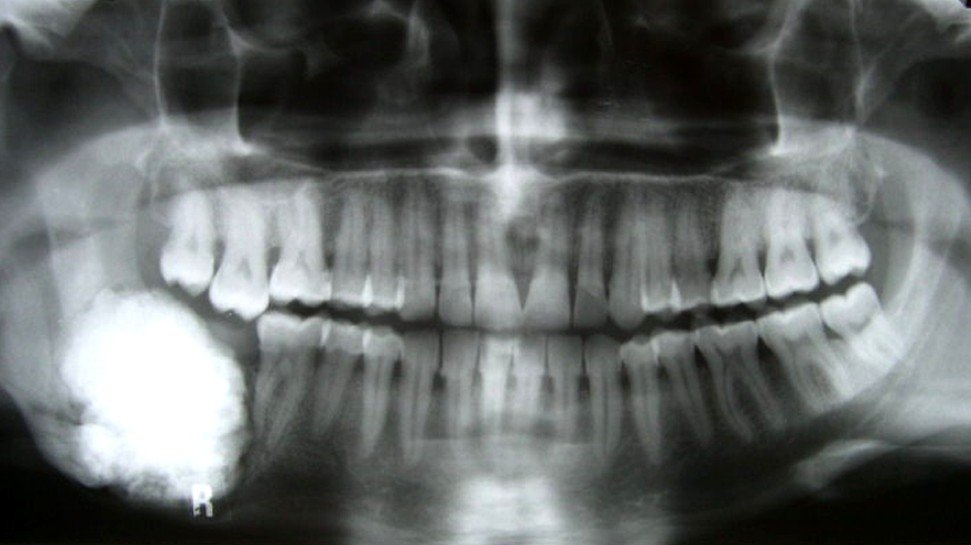Complex Odontoma
Last reviewed by Dr.Mary on February 1st, 2019.
What is Odontoma?
This is a type of benign or non-cancerous tumor located in your mouth. It is made of some or all of the tissues that make the teeth. When looking at this formation it may or may not be arranged to look like a tooth. You may not even be able to see it with your naked eye.
The four parts of an odontoma include the:
- Enamel – this is the hardest part of your tooth that is visible and covers the crown
- Dentin – this is the part of the tooth that is covered by the enamel and cementum and surrounds the entire pulp
- Pulp – this is the center of your tooth and made of cells and living connective tissue
- Cementum – this is the calcified substance covering the root of the tooth
An odontoma will usually grow at the same rate as your teeth but the mass is disorganized. Any one of the components of an odontoma can become the dominant part. Most odontoma are found in children around the age of fourteen when a tooth has not emerged. They can be found in both males and females.
Types of Odontoma
Although there are several types of odontoma these are the two general types.
- Compound odontoma – these also have all the dental tissues present but they are organized into tooth-like structures. Because it is decalcified the enamel will look like spaces around a tiny tooth structure. When you look closer you will see the calcified mass as many small tooth-like bodies or as a solid mass. It can be distinguished from other possible tumors because it can be separated easily from the bony location. These are more commonly found in the anterior jaw region.
- Complex odontoma – this type of odontoma is found in males up to the age of thirty. These odontoma have all the dental tissues represented but they are not in an organized form and have no resemblance to teeth. At the cellular level this one appears as mostly dentil that encloses hollow spaces. The circular spaces are decalcified but at one time they held enamel. There may be a thin layer of cementum on the edges, which forms a capsule like tissue. This is what surrounds the mass. These are more commonly found in the posterior jaw region.
Some other forms of odontoma include:
- Composite odontoma – consist of both dentine and enamel in a pattern that is abnormal
- Radicular odontoma – formed when the root was developing or associated with a tooth root
- Temporal odontoma – commonly found in the mastoid process of the temporal bone and is manifested as a discharging sinus at the base of your ear
What are the Symptoms of Complex Odontoma?
Complex odontoma have many symptoms but they are often misdiagnosed or overlooked. Some are misdiagnosed because you or the dentist thinks it is an impacted wisdom tooth. One serious symptom is having difficulty with swallowing. If there is a tooth that is supposed to be erupting but it is not then this could be another sign of a complex odontoma. You may also feel a lump in your gums. The bone beneath your tooth could also be enlarged.
Causes of Complex Odontoma
No one knows for sure exactly why a complex odontoma occurs but some feel that it could be from an infection and/or trauma to the site. Some dentists believe they develop because of genetic mutation or they are hereditary. One example of an inherited syndrome that might cause complex odontoma is Gardener Syndrome. This syndrome is responsible for a range of tumors in the body, including complex odontoma occasionally.
Pictures
Some of the pictures of Complex Odontoma…
Picture of Complex Odontoma (Graphic)
Diagnosis
A complex odontoma does not usually show any external symptoms. They are normally revealed when the dentist takes x-rays and looks at the x-rays.
Treatment
The only real treatment for complex odontoma is to have surgery to remove them. It is beneficial if the complex odontoma can be discovered and treated early. Removing it is a fairly simple extraction because it is made of dental tissue and is a benign tumor. You can expect to recover rather quickly but in some cases there can be complications after extracting a complex odontoma. Make sure that you stay in contact with your surgeon.

